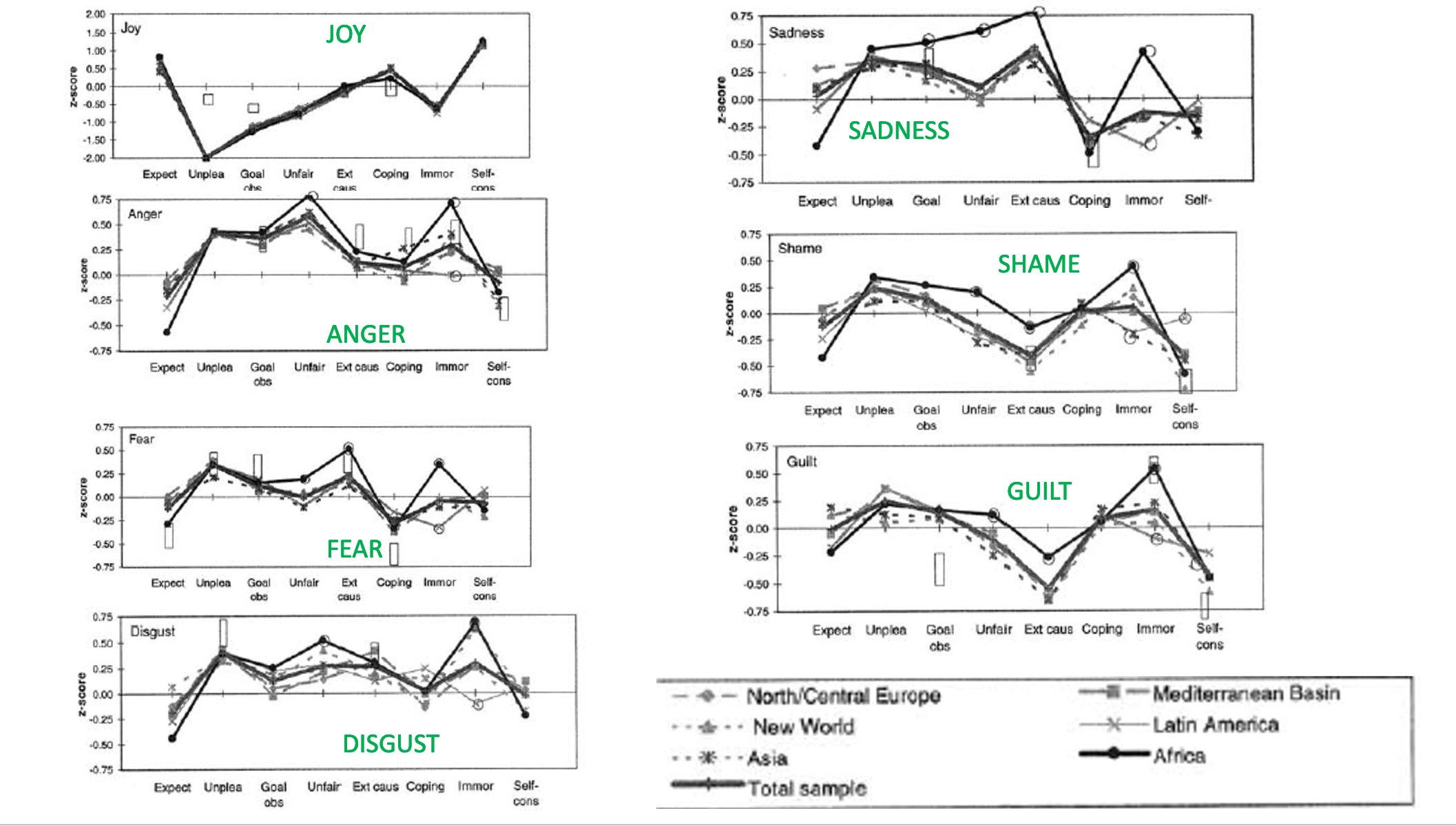Chapter 3: Basic Emotion Theory and Social Constructivist Theory
Cognitive Appraisals
Researchers also disagree over whether changes in cognitive appraisals are unique and universal for each emotion or whether interpretations vary across cultures. Similar to physiological patterns, we will look for how changes in cognitive appraisal patterns may be similar or different across cultures.
A classic study (Scherer, 1997) investigated how cognitive appraisal dimensions varied according to the emotion experience and to the culture of the participant. In this study, participants from six different world regions recalled a situation in which he or she had recently experienced one of seven strong emotions (this recall technique is a common way to elicit an emotion in the laboratory). While thinking about this situation, participants rated the emotional experience along eight cognitive appraisal dimensions (see the dimensions below). Participants completed this process for all seven emotions.
| 6 Regions |
|---|
| North/Central Europe |
| New World |
| Asia |
| Mediterranean Basin |
| Latin America |
| Africa |
| Average Example |
| 7 Emotions |
|---|
| Joy |
| Anger |
| Fear |
| Sadness |
| Disgust |
| Shame |
| Guilt |
| 8 Cognitive Appraisals |
|---|
| Novelty |
| Unpleasantness |
| Goal Obstruction |
| Unfairness |
| External Causation |
| Coping Ability |
| Immorality |
| Self-Consistency |
Graphical findings are displayed below. Each box displays the cognitive appraisal changes for a specific emotion. The x-axis corresponds to the cognitive appraisal dimensions. The coding for each appraisal dimension follows the figures and explains the meaning of a positive and negative score. Finally each line represents participants’ responses from a specific world region. The “total sample” line represents the average score across all participants and is located at zero on the y-axis. Because the y-axis scores are z-scores, this means the total sample line represents the average responses across all seven emotions across the six cultural regions. As we discuss a variety of emotions, we will return to this study. When interpreting the data, looking at Table 12 will be helpful. Table 12 shows the questions and corresponding response scales for each cognitive appraisal dimension.
Figure 17
Eight Cognitive Appraisal Ratings for Seven Emotions across Six World Regions

Table 12
Cognitive Appraisal Dimensions and Corresponding Questions and Response Scales
| Cognitive Appraisal Dimension | Question | Response Scale |
|---|---|---|
| Expectedness / Novelty | Did you expect this situation to occur? | 1 = not at all; 2 = a little; 3 = very much |
| Unpleasantness | Did you find the event itself pleasant or unpleasant? | 1 = pleasant; 2 = neutral; 3 = unpleasant |
| Goal Obstruction | Did the event help or hinder you to follow your plans or achieve your aims? | 1 = it helped; 2 = it didn’t matter;
3 = it hindered. |
| Unfairness | Was the situation unjust or unfair? | 1 = not at all; 2 = a little; 3 = very much |
| External Causation | Who do you think was responsible for the event? | 1 = self/internal;
2 = close persons/external; 3 = other persons/external; 4 = impersonal agency/external |
| Coping Ability | How did you evaluate your ability to act on or to cope with the event and its consequences? | 1 = powerless;
2 = escape possible; 3 = pretend nothing happened; 4 = no action necessary; 5 = could positively influence event and change consequences |
| Immorality | Would this behavior itself be judged as improper or immoral by your acquaintances? | 1 = not at all; 2 = a little; 3 = very much |
| Self-Esteem | How did this event affect your self-esteem? | 1 = negatively; 2 = not at all; 3 = positively |
Adapted from “The Role of Culture in Emotion-Antecedent Appraisal,” by K.R. Scherer, 1997, Journal of Personality and Social Psychology, 73(5), p. 905, 911 (The role of culture in emotion-antecedent appraisal.). Copyright 1997 by the American Psychological Association.
This study revealed some important findings. Joy is the only emotion that shows universality in cognitive appraisals. Across cultures, when people recall a joyful event, they report the following appraisals:
- Event was expected
- Event was pleasant
- Goal was facilitated
- Event viewed as fair
- Event neither caused by an internal nor an external event
- Perceptions that one can cope with event
- Event was viewed as moral
- Event increased self-esteem
One main cross-cultural difference occurs for the cognitive appraisal dimension immorality. These cross-cultural differences were mainly driven by African participants reporting emotion events to be highly immoral and Latin American participants reporting emotion events to be highly moral.
As stated above in the physiology sections, basic emotions researchers would expect a unique pattern of cognitive appraisal changes that correspond to each emotion. These findings indicate that the emotions guilt and shame show similar cognitive appraisal patterns as well as anger and disgust. These similarities are interesting, because some people believe guilt and shame represent the same emotion and that anger and disgust represent the same emotion! (more on this later).

